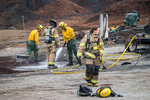
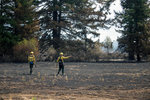
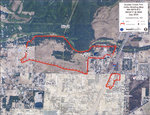
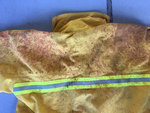
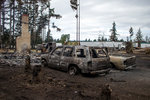
Firefighters knew they were in for a long day when they saw the flames from a Grand Mound brush fire hit tall, tinder-dry grass Tuesday afternoon and shoot 30 feet in the air right in front of them.
“It was like a wall of fire,” Mike Morales, a West Thurston Regional Fire Authority firefighter, told The Chronicle.
On Thursday, as crews continued to patrol fire lines and put out hotspots, Morales and others recounted the harrowing first few hours of the fire in which two fire engines and crews were briefly overrun with flames. Rapidly changing winds set the fire charging across prairie grass, and about 100 residences were evacuated.
While the fire’s initial chaos caused them to fear the worst, crews confirmed by Thursday the damage wasn’t quite as bad as first expected, Capt. Lanette Dyer, of the West Thurston Regional Fire Authority, reported.
By then, crews were able to decrease the estimated number of destroyed primary residences from four to two.
In addition, two outbuildings, two front loaders, three semi trailers, one historical cabin, a historical barn, two personal vehicles, one excavator, two commercial vehicles, one commercial building, a tub grinder, utility poles and 494 acres of land burned. About 345 acres of that was in the Scatter Creek Wildlife Area, according to a news release from the Washington Department of Fish and Wildlife.
On Friday, Thurston County officials reported fire crews would likely be on site for another 10 days to continue mop-up efforts on the lingering fire.
“Thirty-one years in the fire service — this is the largest wildland fire I’ve seen on the west side of the state,” said West Thurston Fire Authority Chief Robert Scott, who was the incident commander on day one of the fire.
At about 1:30 p.m. Tuesday, firefighters responded to what on another day might have remained a small brush fire. However, it was burning close to the Scatter Creek Wildlife Area at a location Scott described as about 1 square mile with tall grass and little access for fire trucks.
“Once the fire spotted into there with the wind behind it, it was able to burn unchecked, burning its own path,” he said.
Scott predicted the fire would get out of hand quickly and called in additional resources, said Dyer.
“He’s not going to brag about it because he’s just doing his job,” she said. “He understood that weather pattern … and he called early and he called for a lot. Chief Scott understood what he had right away.”
Scott shied away from the credit Dyer gave him.
“I work with a great team of people,” he said. “Those are the guys that put themselves in harm’s way.”
For the rest of the afternoon and evening, crews struggled to get ahead of the fire. They’d set up to attack it only to have the wind change direction and have to start all over.
“It was burning faster than we could get to it,” Scott said.
At one point, the fire burned into timber on the west side of Interstate 5 and a gust of wind blew it into a neighborhood along Loganberry Street on the east side of the freeway.
In that area, the fire burned two homes and Jags Top Soil. An engine was on scene before the fire was spotted as a precaution, Scott said.
“The flame front came through there with such ferocity they had to abandon it,” Scott said. “It was a minute-by-minute decision to save a house or get out of there.”
Crews thought the apparatus would be a total loss, but were surprised to find it relatively undamaged.
“There was actually flames burning in the cab of the rig,” Scott said.
Meanwhile, on Guava Street in the main body of the fire, another fire crew was briefly overrun with flames. That fire truck was also saved, Dyer said.
Bob Johannes has lived for 24 years in his home on the corner of Loganberry Street and 185th Street Southwest on the east side of Interstate 5 in Grand Mound.
Tuesday’s fire burned up to the road across Loganberry from Johannes’ house and up to his fence behind the home. He said firefighters credited his home’s extensive garden and green lawn with saving his property.
“It was well-watered,” he said. “That’s why it didn’t burn.”
Johannes said he and his neighbors set up hoses to prevent the fire from spreading as it burned out of control Tuesday evening.
He remembers the moment the fire first flared in his neighborhood.
“As I was mowing the lawn I was watching the smoke from the wildfire,” he said. “And all of a sudden I smelled smoke.”
Johannes looked across Loganberry to see smoke and flames. He said he believes the fire wasn’t started by embers blowing across the freeway, but from a cigarette from a passing car.
However, firefighters on the scene disagreed.
“The timing was too coincidental,” Scott said.
Dyer noted that residents should create “defensible space” around their homes in the event of a wildfire by clearing up dry brush and other flammable materials.
“We still have summer left. It is not too late to create defensible space,” she said.
Mike Morales was off duty Tuesday afternoon when he saw the smoke and grabbed a fire engine with partner Chris White and went to work.
“You couldn’t see at all,” he said. “The first house we came to was already getting structural protection so we went to the second.”
Firefighters were stationing their units at homes to protect them as wildland firefighters worked to stop the fire in fields.
The two went to work trying to divert the path of the wildfire around the home.
“We were working our butts off … and all of a sudden you hear this big tanker,” Morales said.
He ducked as the DC10 tanker dropped a load of red fire retardant right on top of them.
Dyer said retardant is not toxic, but should be washed off homes and vehicles soon to prevent stains.
At the time, firefighters weren’t concerned about that, but were pleased with the help they got from the DNR’s air support.
In the end, the outbuildings burned, but Morales and White saved the home.
Lt. Brandon Betts was also off-duty when he saw the plume of smoke.
“When I went to work my wife went to move her parents, who were in the path of the fire,” he said.
Betts responded to an area near a salmon hatchery and evacuated the business and area residents. When he arrived, the fire was angling away from the area, giving residents a chance to grab belongings.
“There was a big wind change,” he said.
Suddenly everyone had to run out of the path of the fire.
For Betts, one loss in Tuesday’s fire is personal. The historic Miller-Brewer house, in the Scatter Creek Wildlife Area, was his family’s homestead.
“What’s left is a historical marker,” Scott said.
Dyer said firefighters take all of the losses from Tuesday’s fire personally, even if the tally of what they saved far outweighs what they couldn’t.
“There was a heartbeat there,” she said. “There was a story.”